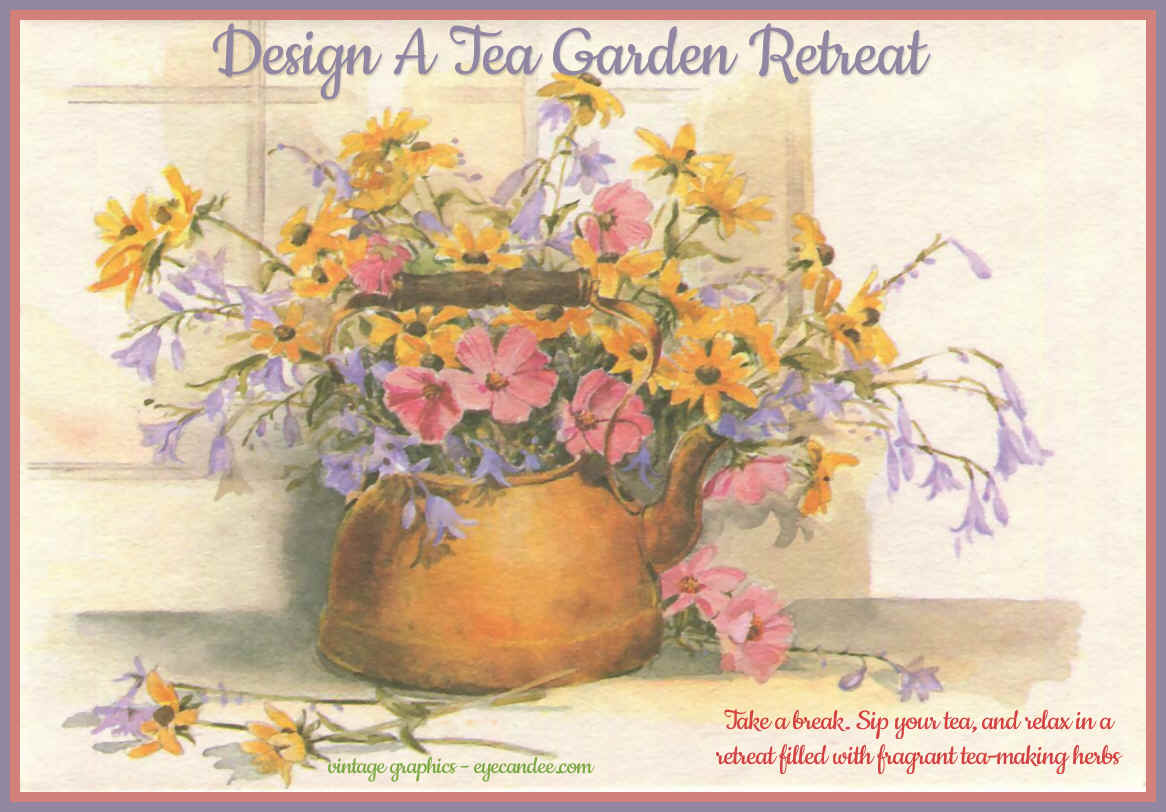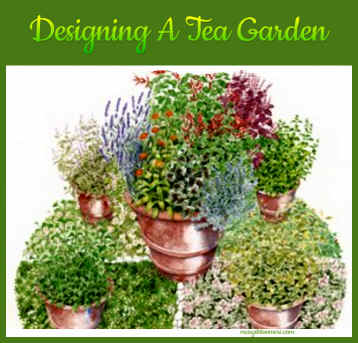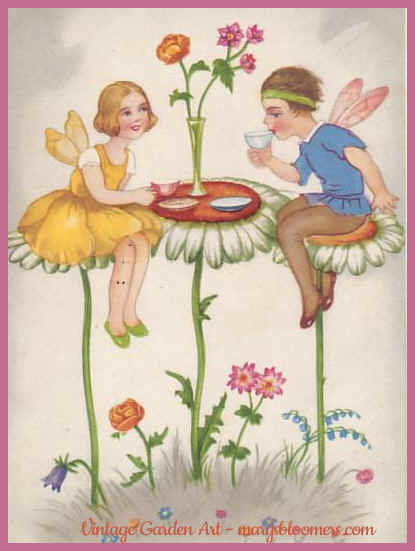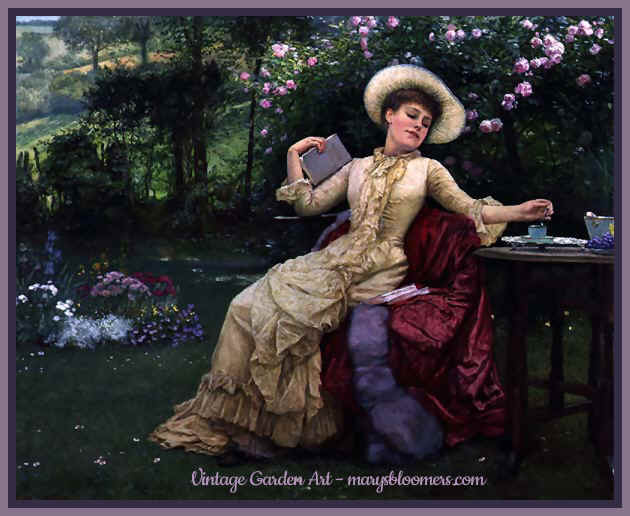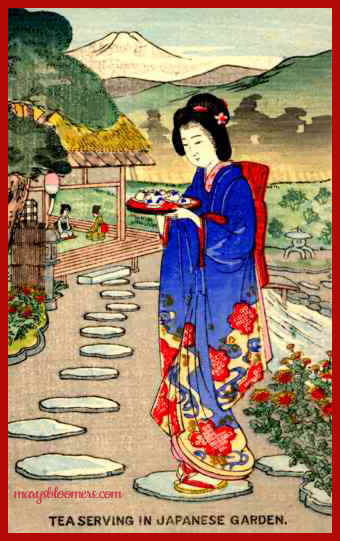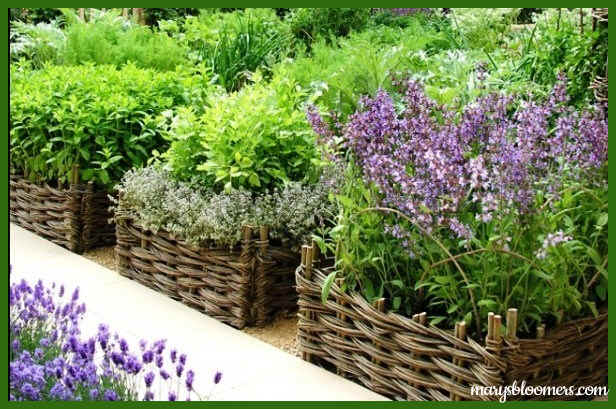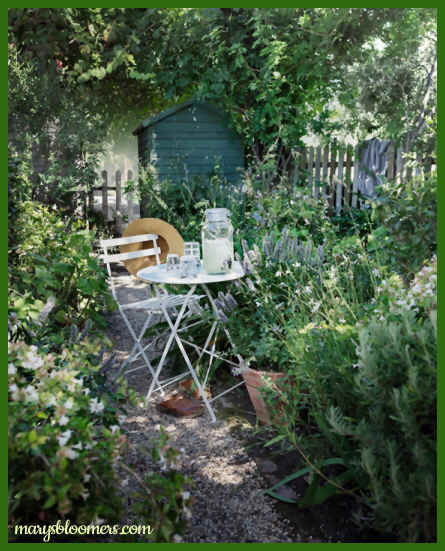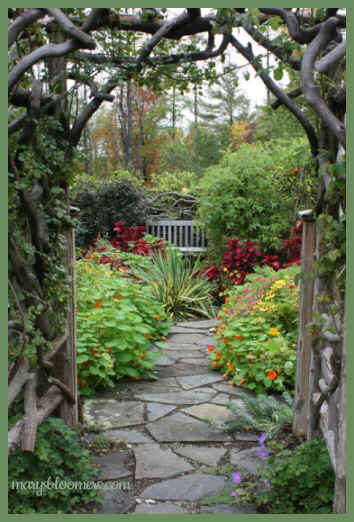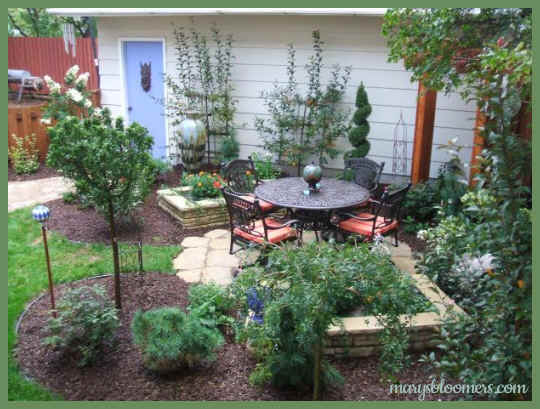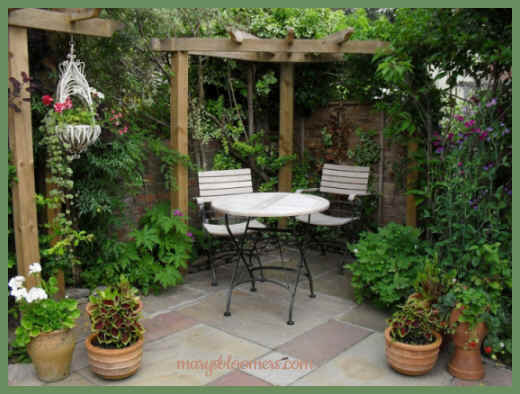|
|
|
A garden plan for growing herbs
used in flavoring and making teas.
Use your own
design, or
download
the herb garden design plan shown above If the soil in the desired area is undesirable, use pots on stones or in fern planters, or grow in an elevated raised bed with well-draining, rich and healthy soil. I add compost to most of my potting mix. Plant the garden in a sunny area. It would like at least 6 hours of sun per day. Scatter a few solar light strings, solar plant stakes, or small solar lanterns around the garden area for amazing evening ambience, and so that you can visit and enjoy your tea garden at night. Evening in my garden is my favorite Mary Time. Many plants have fragrances that are stronger dring warm nights, and when the dew is on them. The Moonlight Garden Design has a list of those fragrant plants that you can place around your tea garden, or along a path leading to it. Use citronella candles, or grow some citronella, to keep out uninvited bugs. Incense sticks poked into the ground around the garden work well. I don't have a bug problem. I have birds inhabiting the gardens that control them. Choose plants that star in your favorite herbal teas and those that grow in your hardiness zones. Those that don't can spend all summer in your garden, and spend the winter as houseplants. Harvest your crop regularly by pinching off leaves so that they remain bushy and compact. Apply fish emulsion or epsom salts fertilizer monthly to keep them bushy and growing fast. For a look at traditional Japanese gardens for decor and landscaping ideas, visit this page. Later on, i will write about Japanese Tea Gardens and the Traditional Japanese Tea Ceremony. If you ever saw the movie, "Shogun", you are familiar with the custom. At the bottom of the article, i will list recommended books and garden items to help make it easy to grow and care for your tea garden and plants. I hope to dig up some herbal tea and teatime recipes for you, as well.
If you have an outlet near your garden, score one for the hotpot. I love that 1 minute to boiling pot. If you don't have power near the tea garden, boil your water and bring it outside for your break. A pretty little thermal carafe will keep your water or prepared tea hot for a while while you relax and sip. Or just bring out your antique teapot filled with the hot water or tea into the garden. Get a bamboo tray with an edge around it to carry stuff into and out of the garden, like your pot, cup, spoon, honey pots, scones, and jam pots. If you have antique linens, bring out a tea cloth and pretty napkins. Consider the tea garden to be your sacred space. A bistro table with 2 chairs allows you to invite someone into your zen space. Set the extra seat aside if you're sipping solo. Or sit a potted plant on it until you need it. You can also make sun tea to have ready when you are. Add a pretty windchime, a lantern here and there, a spiritual piece of decor, and your retreat will be heavenly.
Find
a special time for your tea ritual. I like evenings after dusk, and
mid-mornings as my coffee and tea-sipping times. It's very quiet and
serene. The ritual makes it an expected planned and treasured respite
before or after your gardening chores or during stressful times, and it
also forces you to slow down and really smell the roses, and enjoy the
fruits of your labors. The Garden and The Decor Decorate with dwarf clumping Bamboo in pots, dwarf conifers and dwarf japanese maples for an Asian style evergreen touch - that's part of my personal zen atmosphere. I'm wild about clumping bamboos in asian-style ceramic or stone pots. Delicate leaves and evergreen. I place my collection of jade plants in the garden beds as accents, and on tables. I use medium clusters of smooth black and white smooth stones throughout the garden, and at the bases of potted trees and plants. I have a few dwarf and lacy-leafed trees that look beautiful around my asian-style gardens. They would set the scene for my tea garden retreat. Always check your hardiness zone, and research your plant ideas for information about toxicity or health concerns before drinking them. Make teas solely with the herbs, or add the herbs to your favorite cup of pre-blended herbal tea. Use lemon balm, lemongrass, and a dwarf meyer lemon tree in a big pot as a focal point or specimen plant. With the dwarf meyer lemon, you get regular size lemons. The tree is ornamental, and the leaves and white flowers are pretty and fragrant in the garden. It also grows beautifully as an indoor plant. I live in a cold zone, so i bring it in all winter. It has pretty, glossy leaves and it keeps them, and the white flowers smell sweet. Not fussy. Use the leaves of the lemon herbs for teas and cooking. The
herbals and florals found in herbal teas on the grocery shelf, and the
culinary herbs served to you in restaurants, are a good indication of
what's safe to drink in your tea. Be aware that the leaves
and parts of many plants not commonly ingested in our foods can be
poisonous, so do your homework on culinary herbs and herbal
medicines. All of the suggested herbs and flowers look stunning in designed herb and flower gardens, so you don't have to confine all of them within the tea garden design. Put some in the rest of your garden. It also helps in pollination. Harvesting - Avoid a bitter taste to the leaves and prevent wilting by picking in the early morning or in the evening. Swish the herbs in cold water to clean, then dry. For today's tea, pick and use them now by steeping in your cup, or you can keep cuttings fresh in a vase of water and use within 5-7 hours.
The Plants First of all,
consider growing your tea sweetener. Roses - the petals and hips are used in making teas. Rose hips are packed with vitamin c, and the rose petals add a little sweetness to your blends. I use them in my loose leaf tea blends, and steeped in my teacup. Fill a tea ball and steep it in your herbal tea. chrysanthemums - colorful in fall, the blooms are delicious in herbal tea. Pot marigold
(Calendula officinalis) 18 inches tall, bright orange blooms.
Petals or whole flowers make a slightly bitter tea. Annual. Dwarf Fruit trees - there are dwarf varieties of citrus and many other types of fruit trees, many of them cold hardy, and most do well brought into the house if they're not. Suggested trees that I grow indoors and out: are Meyer Lemon, Persian Lime, and if you've never experienced fresh sweet figs along with your tea, or tasted fig preserves, grow dwarf fig trees. They're tough, and several varieties are cold hardy to zone 4. Pomegranate, and apricot. Many fruits can be the preserves accompanying your tea, or dried and added to steep in your tea in your tea garden. Wild Strawberry- planted 8 inches apart; 8 to 10 inches tall. Small white flowers The leaves make a fruity tea; and the fruit can be dried or floating in your tea. It tastes good combined with sweet woodruff or stevia leaves. Zones 4 to 8. Chamomile.
Daisy-like flowers; soothing at bedtime and when you're
stressed. Looks very cute in any part of your garden. Anise hyssop. Hardy perennial with fragrant spikes of purple blossoms. Licorice flavor. Fennel bulbs can be grown for another licorice-tasting herb. Bee Balm (monarda) - This is a no-fuss plant that pollinators love. Petals are used in tea. Some varieties have a mint base., like ‘PetiteDelight’ (Monarda citriodora). Bee Balm is a rock star as a pollinator magnet, and blooms profusely all season. Their fragrance is sweet. Aromatic Bee Balm makes a medicinal tea with a mild mint flavor. It reportedly fights colds and flu, and is soothing to a sore throat. It's a beautiful ornamental plant, when covered in blooms. I have several varieties. They're easy to propagate... They like to spread out a little. Just pull out a stem with roots and there you go. I have them in pots and beds. No maintenance. Deadheading encourages it to flower again. Passionflower - Tea made from the leaves is relaxing. This is a beautiful flowering vine. Grow it on trellises, in pots along fences, or growing on arches. It can be invasive if not potted up. Lemon anything... I use a lot of lemon flavor in cooking and beverages. All lemon flavored
herbs are appropriate in the tea garden, and
they are refreshing and fragrant. Lemon verbena. Sprawling, aromatic perennial. Keep it in a pot because it wanders quickly. Golden lemon thyme (Thymus x citriodorus 'Aurea') trailing, 6 to 8 inches tall; pungent, small, gold-rimmed leaves and tiny pinkish flowers. Leaves make a spicy emon tea. Lemon balm
(Melissa officinalis 'Aurea') 12 to 24 inches tall; hardy perennial
with mintlike foliage; prune regularly. Lemon-scented leaves make a
refreshing hot or iced tea. Zones 4 to 9.
Pineapple mint
(Mentha suaveolens 'Variegata') 12 to 24 inches tall; wrinkled,
woolly leaves edged in cream. Not as robust as some other mints. Fragrant
pineapple tea is delicious hot or cold. Zones 7 to 9. Purple basil (Ocimum
basilicum 'Purple Ruffles') 18 to 24 inches tall; purple-black
leaves; clusters of pink flowers in a loose spike. Keep pinched for
bushiness. Leaves and flowers make a pinkish tea, with mild peppery clove
overtones. Annual.
Steep Times of some herbs
Bee Balm – Steep Time: 15 minutes. A tablespoon of dried petals or 2 tablespoons of fresh petals Rose - Petals and hips – Steep Time: 10 minutes, fresh or dried. The prettiest cup of tea you'll ever have. The rose hips are packed with vitamin C. Chamomile – Steep Time: 5 minutes Holy Basil (Tulsi) – Steep Time: 5 minutes or more. 1 teaspoon of dry herbs or 2 teaspoons of fresh. Lemongrass – Steep Time: 5-10 minutes. Lemon Balm -Steep Time: Approximately 5 to 10 minutes. Mints – Steep Time: Dried leaves-5 minutes, Fresh leaves-8 min. Hibiscus – Steep Time: 5 or 6 minutes. More Tasty Herbs For Your Teas
|
|||||||
|
Design
Ideas You Could Love For Your Tea Garden |
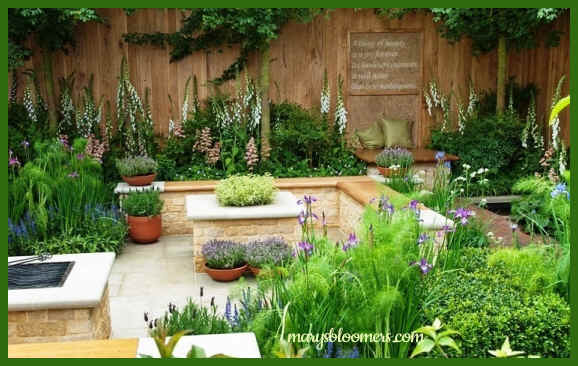 |
|
|
|
|
|
|
|
|
My Recommendations
for Books and Garden Decor For Your Tea Garden are available |
| Sources: Country Living Farmer's Almanac wikipedia Amazon Do It Yourself Network |
|||
|
